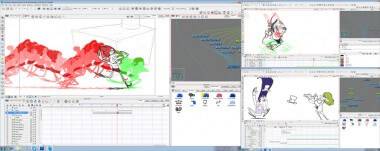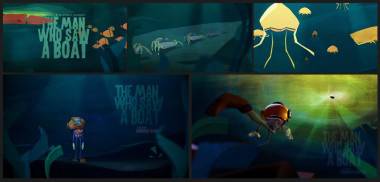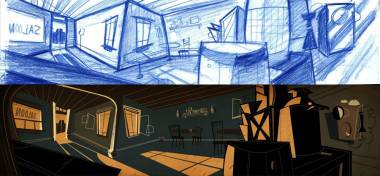Interview with Henrique Barone
Have you seen a short film by Henrique Barone?
The distinctly styled short animated films are making waves. Having recently taken classes in Digital Character Animation at Vancouver film school, He’s been creating animation after animation, Blending 3D and Traditional 2D texture, Henrique has been published within a ‘Art of short films’ compilation book whilst his film “This idea is not working” has been screened online as part of Vimeo Staff picks.
We had a Q&A with Henrique, to discover how he got started, what inspired his latest short, ‘The man who saw a boat” and how he makes his ‘style’.
What started your love for animation?
While studying Design in Brazil I started attending the Anima Mundi Animation Festival and I remember being very impressed and inspired with the variety of stories and especially the use of different techniques. Having no idea how to do Animation I especially got fascinated by those that looked extremely easy to be done, like cut-out and clay, so I decided to do independent shorts and this experience quickly turned Animation into my passion and professional choice.
Do you create all your own concept art for your short films?
I do. The thing I like the most in doing short films is the fact that it incorporates different skills and areas in one single product. By doing a short film you need to think about a script,storyboard, art, animation, composting, sound and everything else.
You have created your own style of drawing and animation, how did you go about finding it?
When I did my first short, This Idea Is Not Working, I was very eager to explore all the possibilities of animation. I wanted to squash and stretch the character as much as I could, morph, transform and all these things. Looking back now it is very clear that this movie is basically me wanting to grasp and execute all the ideas at the same time. And thanks to animation that was actually possible!
In my second film, Toughwest , this creative madness had passed and that’s when I learned to calm down and focus on cinematic choices, to think about the angles, composition and especially the character’s questions, choices and decisions.
The two personal experiences doing these shorts were great and ended up being reflected in the actual films; and I think letting your personal experiences affect your work is very important in the process of finding out your own style.
When I started The Man Who Saw A Boat I faced a curious question: Either you stay in your comfort zone (and you can call it “your own style”) or you try something new and run the risk to “lose your identity”. I don’t think any of the options is completely correct, and I believe that the best and most difficult is to mix the two things, staying true to your style, while bringing something new to the game.
One thing that confused me when I was having the idea for my third short, for example, was the fact that its concept sounded similar to my previous short Toughwest. But at some point I realized that those were just themes I like to work. I also understood that I could approach it in a different way, both in the cinematography language and also in the art/style. That way I could escape from my comfort zone, still keeping my identity.
As far as the actual drawing style goes, I think it’s very important to look references and inspiration. When you do that you are mainly developing a eye for things you like and thing you don’t and why you like or you don’t. That way you start having an opinion about other people’s art and, most important, your own art.
What was your initial idea for The Man Who Saw A Boat?
With The Man Who Saw A Boat my main goal was to focus on Acting and subtle animation. Although there is acting in anything you animate, that wasn’t the focus of my two previous shorts. I started developing the concept by drawing some isolated and unrelated dramatic/appealing shots. I thought it could be good to start with a guy hanging on a cliff and have the story going from there, or someone working on a gas station at 3am when nobody is there. Among those shots I drew a man with a diving bell and right above it a fisherman in the wide ocean, then I drew the fishing rod’s line and both were suddenly connect! The diver and the fisherman sounded like appealing characters by themselves, I liked the vertical communication they could have and the fact that they were in different worlds. Some pages back in my sketchbook I had some random thoughts and lines about “expand yourself”, dream worlds, “free your mind”, “searching for the unknown”, “looking inside” and basically about Evolution/Upgrowth. Out of those concepts + the diver + the fisherman The Man Who Saw A Boat literally emerged.
The Man Who Saw A Boat, has an amazing blend of 2D and 3D, did you have to adapt your illustration style to suit the 3D animation?
I actually did the opposite. I adapted the 3D to suit my 2D style, especially the Character Design.
I think Character Design is one of those things where you can see that the beginning for any idea is a pencil and a paper. In my opinion, constraining the possibilities from your Character Design based on what the computer can handle is not a good idea. Of course you need to consider it, but I wouldn’t design a Character simply based on that. I had a hard time translating my 2D graphic character to 3D, but I think there is some beauty and also some rewards when you “challenge” your medium.
Also, I think when you mix techniques there is a great potential to achieve unique looks and coming from a background in Drawing and Classical Animation, one thing I had very strong in my mind when I started learning 3D was to mix it with 2D. I don’t see a lot of this mix out there and I felt it could be something very cool to explore. But that mix was also one of my biggest fears, since I had no time to really test it before and make sure it would work and look good. I’m glad at the end they blend well together, I think.
Any future shorts in development?
Right now I’m mostly sending The Man Who Saw A Boat to Animation Festivals as well as promoting it online. Also, I recently joined the amazing team of Giant Ant and I’m very happy about it! There is variety of projects, styles and techniques that are definitely very inspiring to work on.
Can you tell us about Toughwest and how you decided to create the idea?
At Vancouver Film School the Flash film schedule has just 1 month. I knew it would be tight so I decided to choose a very specific genre and explore its cinematography characteristics, like angles, timing and pacing. I did the same with the style: picked the Graphic Style from the 50’s, which I’m a big fan, and decided to explore it.
Those 2 things set up the mood/style for Toughwest, a Western film with a very distinct graphic style. But the thing I’m most proud of is the story, especially the lines I wrote and the absolutely amazing way they were read by Ron Selmour. I came up with the idea of having a voice over 2 days before the deadline, then I wrote it and Ron read 1 day before. In the delivery date I had a film that truly surprised myself. It was quite a unique feeling.
You have an amazing blog, do you think it’s an important tool for your development as an artist?
Completely! I’m a big pusher for sharing your work online and not just wait until someone see it. Having a short film well presented in your blog it’s a great way to introduce yourself for people you admire and that inspired you. You can ask for feedback, say what you like, ask stuff and be interested.
The same way goes for companies and studios you admire. Don’t wait for a position to be opened. It’s not because the studio has no positions that they won’t enjoy your blog, watch your short and reply to you. So yes, having a well presented place online and not being afraid to share it is very important to show a little bit who you are. In my opinion, a lot of times, knowing how present yourself and communicate is more important than knowing how to animate.
A big Thank you to Henrique Barone, and we look forward to seeing more of his films.




